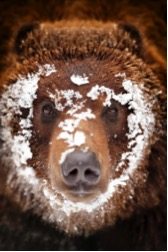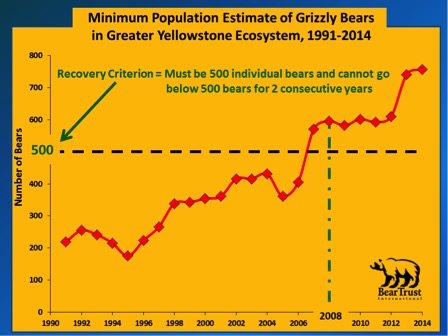As a ranch broker in the rocky mountain west I am fortunate to spend a lot of time on great ranches. The scenery and wildlife are a unique bonus to my job. Seeing a bear is particularly exciting, whether black or grizzly, giant boar or little cub. I’m happy to be a new member of the Bear Trust International, a conservation group grounded in science with a goal to preserve, enhance and protect bear populations and their habitat. The following article highlights a recent topic, Grizzly bear introduction and federal protection. If you share my passion for the Bears of the World I encourage you to join and support this fine group. Craig Jansen, Associate Broker
Are Grizzly Bears in Yellowstone Ready for Delisting
 Montana-based non-profit, Bear Trust International, wants to help everyone determine this answer for themselves. How? The same way that grizzly bear scientists do. Look at the scientific data. Not sure if you can analyze the data? No problem! Bear Trust International has graphed all the data for you. See below.
Montana-based non-profit, Bear Trust International, wants to help everyone determine this answer for themselves. How? The same way that grizzly bear scientists do. Look at the scientific data. Not sure if you can analyze the data? No problem! Bear Trust International has graphed all the data for you. See below.
First, a little background: Grizzly bears in the lower 48 states were listed as threatened under the Endangered Species Act in 1975. At that time, grizzly bears were placed under federal protection with the US Fish and Wildlife Service.
It’s important to remember that the GOAL of the Endangered Species Act is to recover listed species so that they no longer need federal protection and the management of the listed species can be returned to state wildlife agencies.
In 1982, the first grizzly bear recovery plan was created, which identified 6 grizzly bear recovery zones:
Each grizzly bear population in each of the 6 grizzly bear recovery zones can be evaluated for recovery, delisted, or relisted independently. At question today is the grizzly bear population in the Greater Yellowstone Ecosystem. Is it ready for delisting? Well, how do you KNOW when any listed species is ready for delisting? Answer: look at the recovery plan, it provides a road map to recovery with science-based recovery criteria that must be met before a threatened or endangered species can be delisted.
For the grizzly bear population in Yellowstone, the grizzly bear scientists determined over 30 years ago that there are 3 science-based demographic recovery criteria. When these 3 recovery criteria are met, then the grizzly bear population in the Greater Yellowstone Ecosystem is supposed to be delisted. All 3 of these recovery criteria were met in year 2008. How do we know? Look at the data.
For example, let’s look at Recovery Criterion # 1: There must be at least 500 individual grizzly bears in the Greater Yellowstone Ecosystem, and this number cannot fall below 500 for 2 consecutive years. There must also be at least 48 females with cubs and this number cannot fall below 48 for 2 consecutive years.
Bear Trust asked the US Fish and Wildlife Service for the data and then Bear Trust graphed the data for the first part of Recovery Criterion #1 below:
The data clearly show that at least 500 bears were in the Greater Yellowstone Ecosystem by 2007, and by 2008 the number did not fall below 500 for 2 consecutive years. Want to see graphs of data for all parts of all 3 recovery criteria for grizzly bears in the Greater Yellowstone Ecosystem? It’s easy to do! Visit: http://beartrust.org/grizzly-bears-in-yellowstone-proposed-delisting-by-usfws
At Bear Trust, we value the roles that science and hunting play in effective wildlife conservation. Everything Bear Trust does is grounded firmly in sound science.
Want to help Bear Trust ensure long-term, sustainable populations of wild bears through science-based education, wild bear research, habitat conservation, and conservation policy? Please contact Bear Trust’s Executive Director, Dr. Melissa Reynolds-Hogland:
melissa(at)beartrust(dotted)org
Home Office: 406.626.1627
Office: 406.523.7779
www.beartrust.org




